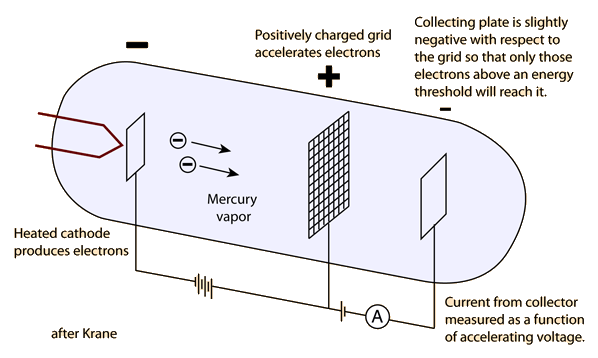James Franck: Difference between revisions
No edit summary |
No edit summary |
||
| Line 17: | Line 17: | ||
[[File:Appdata.gif]] | [[File:Appdata.gif]] | ||
When the current was accelerated to a voltage of 4.9 volts the current sharply dropped. This cause Franck and Hertz to wonder what was taking energy away from the electrons. They concluded that the energy was transported through inelastic collisions between the accelerated electrons and the electrons present in the unexcited mercury atoms. The sharp drop of current indicated that there was a threshold for mercury electrons to accept the energy from the accelerated electrons and elevate the mercury electrons to an excited state. The 4.9 volt value corresponds to a photon emission with a strong ultraviolet line. Franck and Hertz also noted that these current drops occurred at multiples of the 4.9 voltage because electrons could be re-excited after they had returned to their unexcited state and emitted a photon. | |||
[[File:Frank_Display.jpeg]] | [[File:Frank_Display.jpeg]] | ||
Revision as of 21:31, 5 December 2015
Created by Zachary Maciejewski
James Franck was a German Physicist who, along with Gustav Hertz, conducted the Frank-Hertz in 1914 which confirmed the Bohr Model of the atom.
Academic Career
James Franck was born on August 26th, 1882 in Hamburg, Germany. He studied at the Frederick William University in Berlin, where he received a PhD in 1906. Franck obtained the "venia legend" for physics to lecture at the University of Berlin, where he stayed until 1918. He became the Head of the Physics Division in the Kaiser Wilhelm Institute for Physical Chemistry. He became a professor of Experimental Physics and Director of the 2nd Institute for Experimental Physics at the University of Gottingen. The head of the Institute for Theoretical Physics, Max Brown, worked with him on quantum physics. This is the point when he conducted the famous Franck-Hertz experiment which confirmed the Bohr Model of the atom. Simultaneously he promoted the careers of women in Physics such as Lise Meitner, Hertha Sponer, and Hilde Levi. After the Nazi party assumed power in 1933, Franck resigned from his post in order to help Jewish Scientists find work outside of Germany. He then decided to move himself with his family to Baltimore where he lectured at Johns Hopkins. Following a year working at the Niels Bohr Institute in Denmark, he returned to become a professor of physics at Johns Hopkins. In 1938 he left for Chicago to become a professor of physical chemistry at the University of Chicago. During World War II he served as the Director of the Chemistry Division of the Metallurgical Laboratory, the center for the Manhattan District's Project. He also was the chairman of the Committee on Political and Social Problems, where he wrote the Franck Report, which discouraged the use of the atomic bombs in Japan without warning.
The Franck-Hertz Experiment
The Franck-Hertz Experiment demonstrated the existence of excited states in mercury atoms. The experiment was conducted using a device now called a Franck-Hertz apparatus. This device pumped a voltage which accelerated electrons toward a positively charged grid in the presence of mercury vapor, behind which was another grid with a small negative charge that served as a collection plate. The values of the accelerating voltage where the current dropped suddenly and substantially provided the energy necessary to elevate an electron to an excited state. This experiment confirmed the quantum theory which predicted that there were discrete, quantized energy states which electrons occupied.
When the current was accelerated to a voltage of 4.9 volts the current sharply dropped. This cause Franck and Hertz to wonder what was taking energy away from the electrons. They concluded that the energy was transported through inelastic collisions between the accelerated electrons and the electrons present in the unexcited mercury atoms. The sharp drop of current indicated that there was a threshold for mercury electrons to accept the energy from the accelerated electrons and elevate the mercury electrons to an excited state. The 4.9 volt value corresponds to a photon emission with a strong ultraviolet line. Franck and Hertz also noted that these current drops occurred at multiples of the 4.9 voltage because electrons could be re-excited after they had returned to their unexcited state and emitted a photon.
Connectedness
- How is this topic connected to something that you are interested in?
- How is it connected to your major?
- Is there an interesting industrial application?
cs Computer Vision
See also
For more information on Gustav Hertz:
http://www.nobelprize.org/nobel_prizes/physics/laureates/1925/hertz-bio.html
External links
Visualizations:
https://www.youtube.com/watch?v=W0GqNtsmaYU
http://demonstrations.wolfram.com/FranckHertzExperiment/
https://archive.org/details/FranckHertzExperiment
http://vlab.amrita.edu/?sub=1&brch=195&sim=355&cnt=1
References
This section contains the the references you used while writing this page
http://www.nobelprize.org/nobel_prizes/physics/laureates/1925/franck-bio.html
http://hyperphysics.phy-astr.gsu.edu/hbase/frhz.html
https://en.wikipedia.org/wiki/Franck%E2%80%93Hertz_experiment



